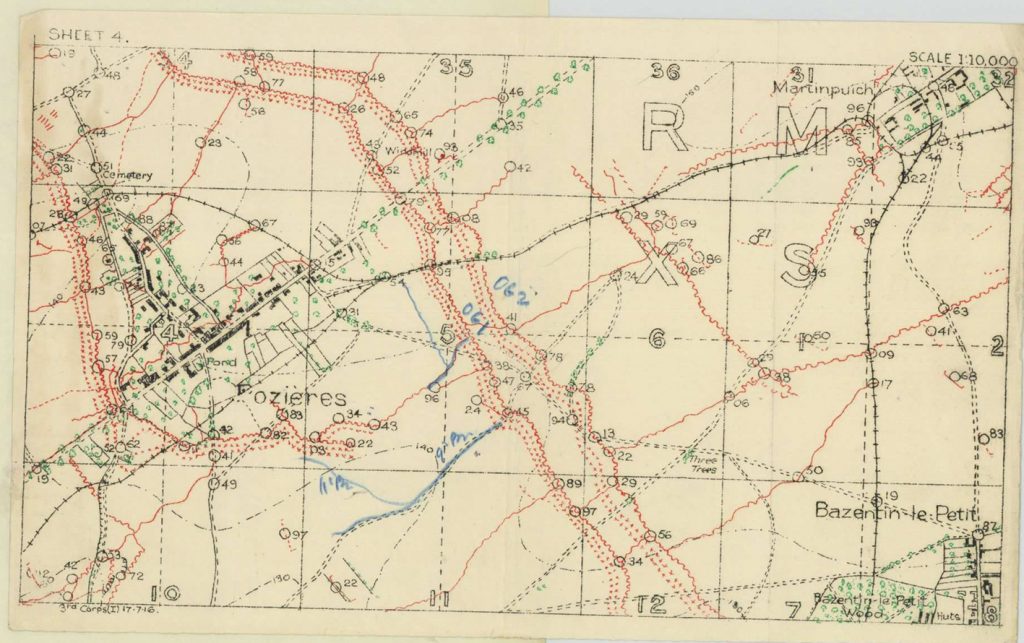Philip Browne is commemorated on the Toowoomba Mothers’ Memorial, but his name is incorrectly spelt without the final ”e”. He enlisted in Brisbane on 24 May 1915. He was a university student (geology) and one month short of his twentieth birthday. His parents were James Arthur and Jessie (Alice) McPherson Browne, of Milton in Brisbane, and Durham Downs, Roma, Queensland. Philip was born on another family property at Taroom. He was educated at the Toowoomba Grammar School, where he was well regarded; the head-master, Mr Barbour, wrote on behalf of the family to the Minister for Defence after the war. Mr Barbour’s own son, Fred, served with Philip in the 9th Battalion, both as sergeants. (Fred Barbour was killed in France in 1917. See Barbour F.G.P.)
Philip began training at Enoggera, where he was posted to the reinforcements for the 25th Battalion. He was a lean man at 5’8” and 129 pounds. He had a fair complexion, grey eyes and brown hair, and stated his faith as Church of England. Having turned 20 years, he embarked in Brisbane on the 30 December 1916 aboard A50 Itonus.
The next stage on the road to war for Philip was in the AIF camps of Egypt, where the new men from Australia were blended with the Gallipoli veterans to create new divisions for service in France and Belgium. Philip was promoted to sergeant at Serapeum in March 1916, and transferred to the 9th Battalion. He sailed with his new unit for Marseilles later the same month.
The 9th Battalion was introduced to trench warfare in France soon after its arrival with a deployment in the far north. Early exchanges with the Germans were bitter, including the brutal art of trench-raids; something the AIF would eventually master as a potent tactic. However, the battalion was destined to fight at Pozieres in July, as part of the Battle of the Somme. The men moved into the trenches ready to storm the village in the early hours of 23 July. During the night, before the advance, Philip volunteered to carry bombs (grenades) up to the front trench. While performing this task he was killed by small-arms fire or shrapnel wounds to the head.
Several eye-witnesses gave accounts of the events to the Red Cross. Private Mossom stated,
We had a bombing stunt the night before the charge at Pozieres on July 22nd. He (Browne) was going back along a communication trench after the raid when he was killed by a shell. Private Cameron said, Sergeant Browne and six or seven others went out carrying bombs for a bombing party, they got into a trench and Browne volunteered to help carry wounded, he left his party to do this, and was shot through the head.
There are discrepancies in some of the details, although the central picture is clear. It must be recalled that these survivors’ statements were made weeks or months after the battle, during which the witnesses had been through the charge, and then endured days of continuous fighting as the battalion lost 316 men in four days.
In the months and years that followed Philip’s parents wrote frequently to the army regarding a range of issues, including: delays in receiving his effects; the lack of news of the precise circumstances of his death (later remedied by the Red Cross); the possibility of his receiving a decoration or recognition for his work bringing in the wounded; and, finally, the inability of the army to locate his grave for interment in a war cemetery. Philip’s name is engraved on the Australian Memorial at Villers-Bretonneux. He had two brothers: Roy (26th Battalion) and Arthur (41st Battalion), also serving in the AIF, both of whom became lieutenants and survived the war.
Finally, an unrelated man, 2/Lt Gordon Browne (42nd Battalion) enlisted in Toowoomba and died of wounds on 2 October 1918. He was from the Mitchell area and is not on the Toowoomba Mothers’ Memorial.
Toowoomba Grammar School Archive Records state that he started school on 9th February 1909 and left on 1st December 1912. The School Magazine dated November 1916 states, ‘Philip G. Browne was at School from 1910 to 1913. He sailed from Brisbane with reinforcements at the end of 1915, and after a period in Egypt was attached to the 9th battalion. In August last he volunteered to join a night party to rescue the wounded from no man’s land and was shot down almost before starting on his noble mission’.
External Links
National Archives of Australia Military Records
Australian Red Cross Society Wounded and Missing
AWM4 unit war diaries Item No 23/26/19 9th BN July 1916

Map of Pozieres 1916

Villers-Bretonneux Memorial, France




